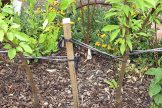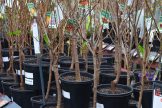
Many vegetables grow well with other plants in the garden and, using a few basic principles, organic gardeners can really have nature on their side in the biological control of pests.
The most commonly documented companion plants help to repel pests when planted alongside vegetables. Other plants attract pest predators to the vegetable patch. Some plant roots secrete substances that repel pests or provide nutrients to the plants around them. These plant interactions can work in specific ways between two or three types of plants or species.
How does companion planting work?
There are 5 ways:
1. Attract Beneficials
Assist pollination of your vegies in the kitchen garden by planting some beneficial, insect attracting flowers in the garden. Go for mixes of Alyssum, Foxglove, Phacelia, Echinacea, Bergamont, Poppies, Calendula and Queen Annes Lace. Also, plant some Coriander and Dill and allow to go to flower.
2. Camouflage
Most pests recognise their food plants by their shape and smell. Good companions can mask smells and break up recognisable plant outlines. E.g. scented geraniums can help to mask the smells of many plants.
3. Nurture
Nuturers can shade young plants, be a support to climbers e.g. beans can climb up corn stalks
4. Stimulate
Some plants may help improve the flavour, productivity or nutrient value of other plants e.g. Borage can help improve the flavour of strawberries.
5. Sacrifice
These companions act as a decoy and are planted at a distance from susceptible plants. Many vegies gone to seed will attract pests to themselves, for example broccoli gone to seed will attract aphids.

Peas and Beans add nitrogen to the soil.
For example, legumes (peas, beans, etc.) trap nitrogen from the air with nodules on their roots. When these crops have finished producing you can dig them into the soil so that the nitrogen is available to the next crop. Being leafy vegetables, the brassica family (cabbages, broccoli, etc.) require a lot of nitrogen to grow, so it makes sense to follow summer pea crops with winter cabbages that can use this free nitrogen source.
The ecosystem approach
Many of these relationships are fairly general. The best results come from an ecosystem approach to gardening, using a wide variety of herbs and ornamental plants alongside the edible crops planted in the garden.
Some companionable plants
- Basil helps repel flies and mosquitoes.
- Birch dead leaves encourage compost fermentation.
- Borage in the strawberry patch may increase the yield.
- Catnip helps repel fleas, ants and rodents.
- Caraway helps breakdown heavy soils.
- Chamomile may deter flies and mosquitoes.
- Chives grown beneath apple trees may help to prevent apple scab; beneath roses may keep away aphids and blackspot.
- Elderberry can act as a general insecticide. The leaves encourage compost fermentation, the flowers and berries make lovely wine!
- French Marigold root secretions may kill nematodes in the soil. They also help to repel white fly from tomatoes.
- Garlic helps keep aphids away from roses.
- Hyssop attracts cabbage white moth keeping brassicas free from infestation.
- Mint helps to repel cabbage white moth. Dried and placed with clothes will repel clothes moth.
- Nasturtium secrete a mustard oil, which many insects find attractive and will seek out, particularly the cabbage white moth. Alternatively, the flowers can help to repel aphids and the cucumber beetle. The climbing variety grown up apple trees will repel codling moth.
- Pyrethrum may help repel bugs if grown around the vegetable garden.
- Rosemary may help to repel carrot fly.
- Rue (Rutus graveolens , not Peganum harmala) can keep cats and dogs off garden beds if planted round the borders.
- Sage can help to protect cabbages from cabbage white moth.
- Tansy (Tanacetum, not Senecio) may repel moths, flies and ants. Plant beneath peach trees and they will help repel harmful flying insects. Tansy leaves assist compost fermentation.
- Wormwood (Artemesia, not Ambrosia) although it can inhibit the growth of plants near it, wormwood may repel moths, flies and fleas and can help keep animals off the garden.
Some compatible vegetables
- Beetroot: Onions, Lettuce, Cabbage, Silverbeet
- Cabbages: Beans, Celery, Beetroot, Onions, Potatoes
- Cauliflower: Celery
- Celery & Celeriac: Chives, Leeks, Tomatoes, Dwarf Beans
- Carrots: Lettuce, Peas, Leeks, Chives, Onions, Cucumbers, Beans
- Broadbeans: Potatoes, Peas, Beans
- Tomatoes: Asparagus, Parsley, Broccoli, Sweet Basil
- Sweet Corn: Potatoes, Peas, Beans





